Rec Center, Emergency Edition: Cold Noodles to Survive the Heat Wave
How to stay cool through slurping
Welcome to the June edition of Rec Center, my miscellaneous recommendation series! You can find recommendations from previous months in the Rec Center archives. Otherwise, the Lillian Review of Books publishes book reviews, mainly of classic and/or Jewish and/or speculative literature.
In most of the United States this week, it is too damn hot. Here in Virginia, we’ve been hitting the upper 90s with moderate humidity. Every time I leave the house, my glasses fog up. It’s too hot for monthly roundups and recommendations. Too hot for culture and literary analysis.
Instead, here are five kinds of ice-cold noodles you could make with a minimal amount of effort and just one pot, because there’s nothing worse than standing over a hot stove when it’s 99 degrees outside. If you took my previous recommendation from December and bought yourself an egg cooker, all you have to boil are the noodles themselves.
I’m lucky to come from a culture that is rich in cold noodles. Naengmyeon originates from the northern end of the Korean Peninsula and was traditionally a winter dish. It is usually made from beef broth mixed with dongchimi liquid, a non-spicy type of watery kimchi made from radishes that are in season in the winter. In the modern era of refrigeration, people discovered that this cold-weather chilly treat is especially refreshing during the hot Korean summers. Different variations on the dish evolved over time.
Kong guksu, or soybean milk noodle soup, developed on a parallel path from the tradition of temple food. Buddhist monks created this gently flavored, vegan noodle dish to stay cool and nourished in the summer heat while abiding by their religion’s restrictions against strong tastes like garlic and onion.
I’m less familiar with the origins of the Japanese and Vietnamese noodles on this list, but they’ll cool you down almost as well as the Korean versions.
One important note that applies to all of the different kinds of noodles: be sure to rinse them in cold water as soon as they’re done cooking. Use your hand to wash them under cold running water like you’re doing laundry by hand. You can be vigorous and really push them against the colander in a circular motion to be sure you’ve rinsed out all the hot water. This isn’t pasta. Washing your noodles will give them a nice chewy texture. Drop some ice cubes in the colander with the noodles while you finish prepping your meal.
Okay! Now pour yourself a nice cool glass of cold-brew hojicha that you made from last month’s Rec Center and get slurping!
Zaru soba
Cold Japanese buckwheat noodles with an umami-rich soy-dashi dipping sauce. My mom makes the best zaru soba dipping sauce, but when it’s 100 degrees I don’t wanna bother with boiling the bonito flakes to make dashi and then waiting for it to cool down. Buy a bottle of concentrated soup base (mentsuyu) at your local Asian grocery store and dilute it with some water and ice. Grate daikon radish, chop green onions, put in your icy broth. Boil soba noodles and soft-boil some eggs. Cut some gim (roasted seasoned seaweed) over your noodles, optionally serve with some wasabi schmeared over the soba. Dunk your eggs into the sauce. Dip, slurp, chill.
Really don’t skip the finely grated daikon or Korean radish, it rounds out the flavor of the sauce and also helps the sauce cling to your noodles. Just note that you should squeeze out some of the liquid after you grate it.
Mul naengmyeon
Chewy Korean thin buckwheat noodles in cold beef and radish broth. I’m going to be honest, I’ve never made my own naengmyeon broth from scratch. It’s commonly served at Korean BBQ restaurants because it goes great with grilled meat, especially in the summer. The broth is tangy, slightly sweet, and incredibly refreshing. You can get packages that have fresh noodles and soup to prepare it at home from the refrigerated section of H-Mart. I prefer the brand Pulmone—if you spruce it up with some egg, julienned cucumbers, radish kimchi, and sliced Korean pear or apples, it’s just about restaurant quality (better than some restaurants).
Throw the bags of soup into the freezer for at least 30 minutes before you serve to get a nice slushy consistency. Or, better yet, store the soup pouches in the freezer and set them out on the counter to thaw as you wait for the water to boil.
Bonus points for some bulgogi on the side.
N.B.: there’s a spicy, saucy (not broth-y) version called bibim [“mixed”] naengmyeon that I usually prefer to accompany grilled meats, but for cooling purposes you really can’t beat the frozen slushy broth of mul [“water”] naengmyeon.
Bibimguksu
Thin wheat noodles with a sweet and spicy gochujang-sesame sauce. This is one I do make from scratch every time because it’s so quick and easy and customizable to your taste. I crave this all summer long and eat it at least twice a week whenever it’s over 80 degrees. The sauce tastes amazing on crunchy cold vegetables, so I load up my bowl with lots of cucumber, shredded cabbage, iceberg lettuce, carrots, pickled radish, or anything else that needs to get used up. It’s basically a giant noodle salad. Top with the ever-present soft-boiled egg.
I don’t follow a recipe, but this is roughly the starting point for the sauce I make: Maangchi’s bibimguksu recipe. I prefer it sweeter than this, though, plus I always use rice wine vinegar for tanginess. Adjust to your taste. Also, this is best with very ripe (extra fermented) kimchi. If you don’t have any, you can skip it and just make it with gochujang and gochugaru and rice wine vinegar.
Quick kong guksu
Nutty, mild, creamy soy milk soup with thin wheat noodles. I made this for the first time this week and it was phenomenal. These noodles aren’t as loud and in-your-face as bibimguksu, but they’re proof that Korean food can be craveable and addictive without being super spicy and bold-flavored. The traditional method involves soaking, cooking, and grinding soy beans, a 12-hour process, but celebrity chef and Culinary Class Wars judge Paik Jong Won’s cheater’s version takes about 3 minutes and uses a block of tofu as a shortcut. Video with full recipe is below, but here’s the summary, with my customary lack of precise measurements:
Toast 4 tablespoons of sesame seeds in a dry pan. Blend a full block of firm tofu, a heaping spoonful of peanut butter, the sesame seeds, about a cup of milk (I used almond milk), a bit of sugar and salt to taste, and some water to thin it out to the desired consistency. I liked mine thick and creamy but still soupy enough to drink. It looked a lot like a protein shake. Chill in the fridge until ready to boil the noodles (I used somyeon, thin wheat noodles) and serve with extra ice in the bowl.
Top with cucumbers, tomatoes, and soft boiled eggs. Serve with kimchi on the side. This made about 4 servings.
I lightly pickled the cucumbers in a sweet brine to try to replicate the flavors in an elevated black sesame kong guksu dish from another Culinary Class Wars alum Edward Lee’s DC restaurant, Shia. Not strictly necessary but it added a nice touch.
Vietnamese bun
Technically I think this dish is traditionally served at room temperature, not cold, but I usually make it into a bastardized chilled noodle salad. Rice vermicelli noodles, lots of shredded cabbage, cucumbers, bean sprouts, pickled radish, mint, Thai basil, and cilantro. Nuoc cham dressing: squeeze a few limes, add sugar/honey/agave and a little water until it tastes like limeade. Add fish sauce until it’s a light amber color and tastes as funky as you want it. Add a couple cloves of minced garlic and as many chopped birdseye chilies as you dare (be careful). Sometimes I go all out and make lemongrass chicken/pork meatballs or chicken thighs to go with the bun, but more often I’ll just shred some leftover rotisserie chicken and call it a day.
Honorable mention: Hiyayakko (Japanese cold silken tofu)
Not noodles, but extra light and refreshing on a molten hot day. I prefer to use ponzu instead of soy sauce.
Dessert
For dessert, you must have chilled watermelon.
Out and About
ICYMI, I had an essay about the concept of worldbuilding and the failures of literary speculative fiction in
this month. interviewed me for their Monday Media Diet series, in which I talk about books, podcasts, and apps, recommend some LitStack luminaries, and make an embarrassing disclosure about who I supported in the 2019 primaries.Also, I have a review of a controversial “Substack novel” forthcoming in the excellent
on Saturday, June 28. Please subscribe to them so you don’t miss it!The LilRB will be back with an actual book review in the next couple of weeks. Til then, stay cool and stay safe. Please let me know if you make any of these noodle dishes!
-Lillian

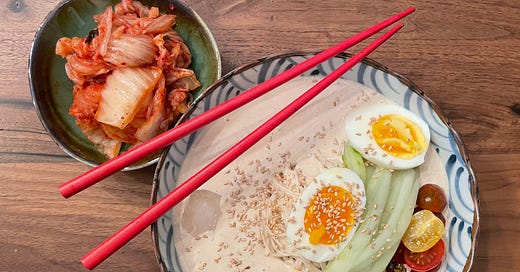


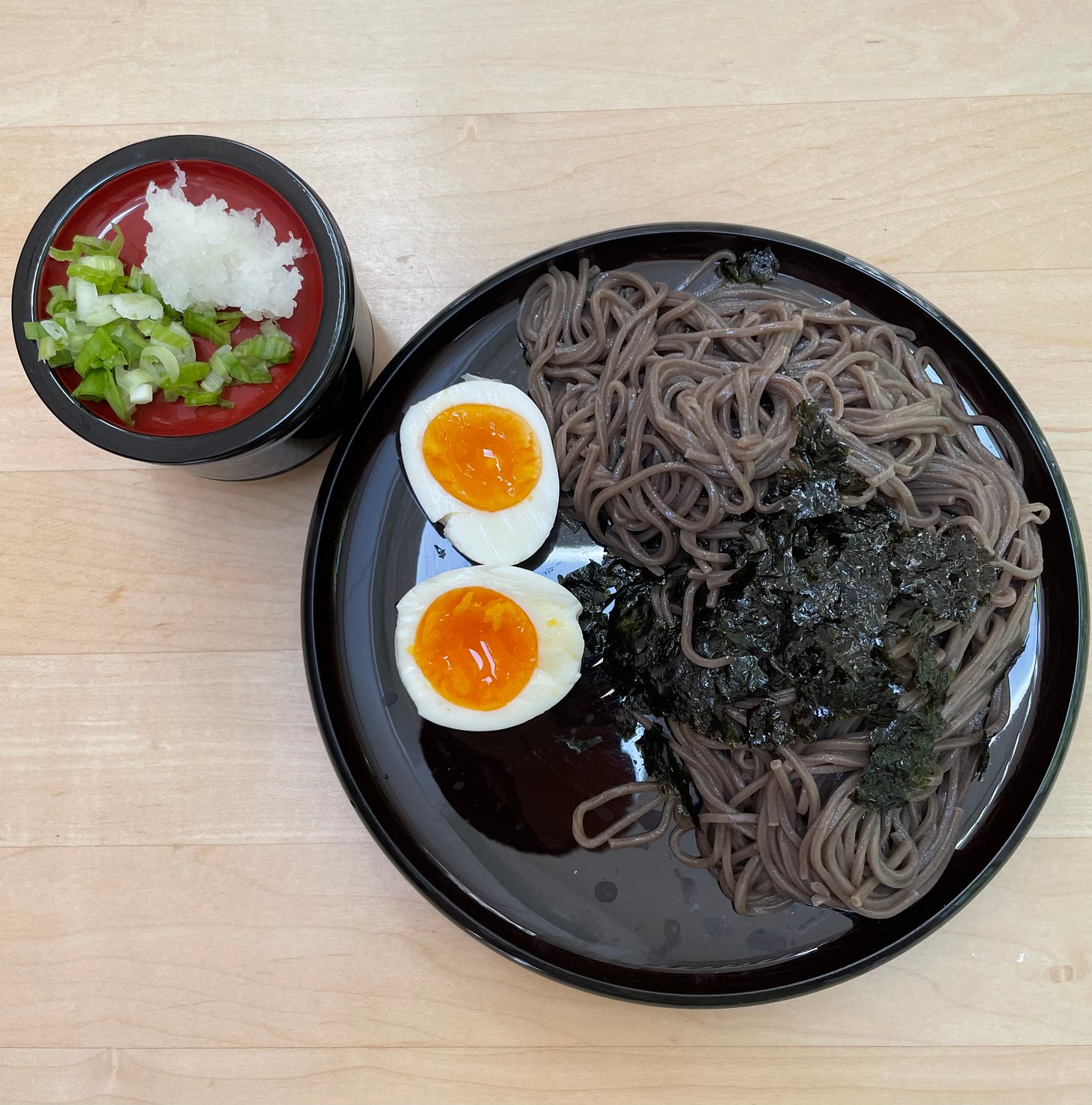
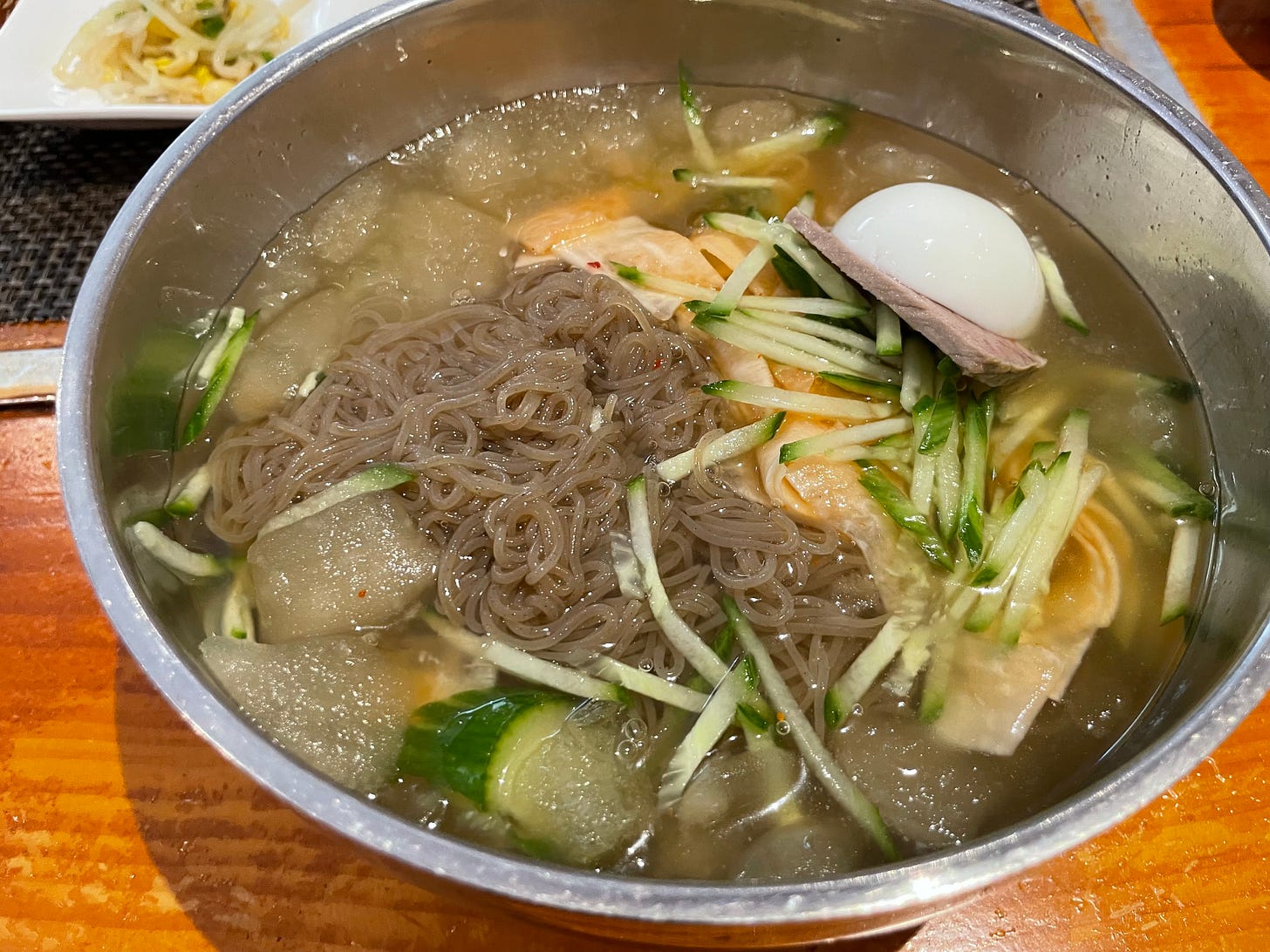
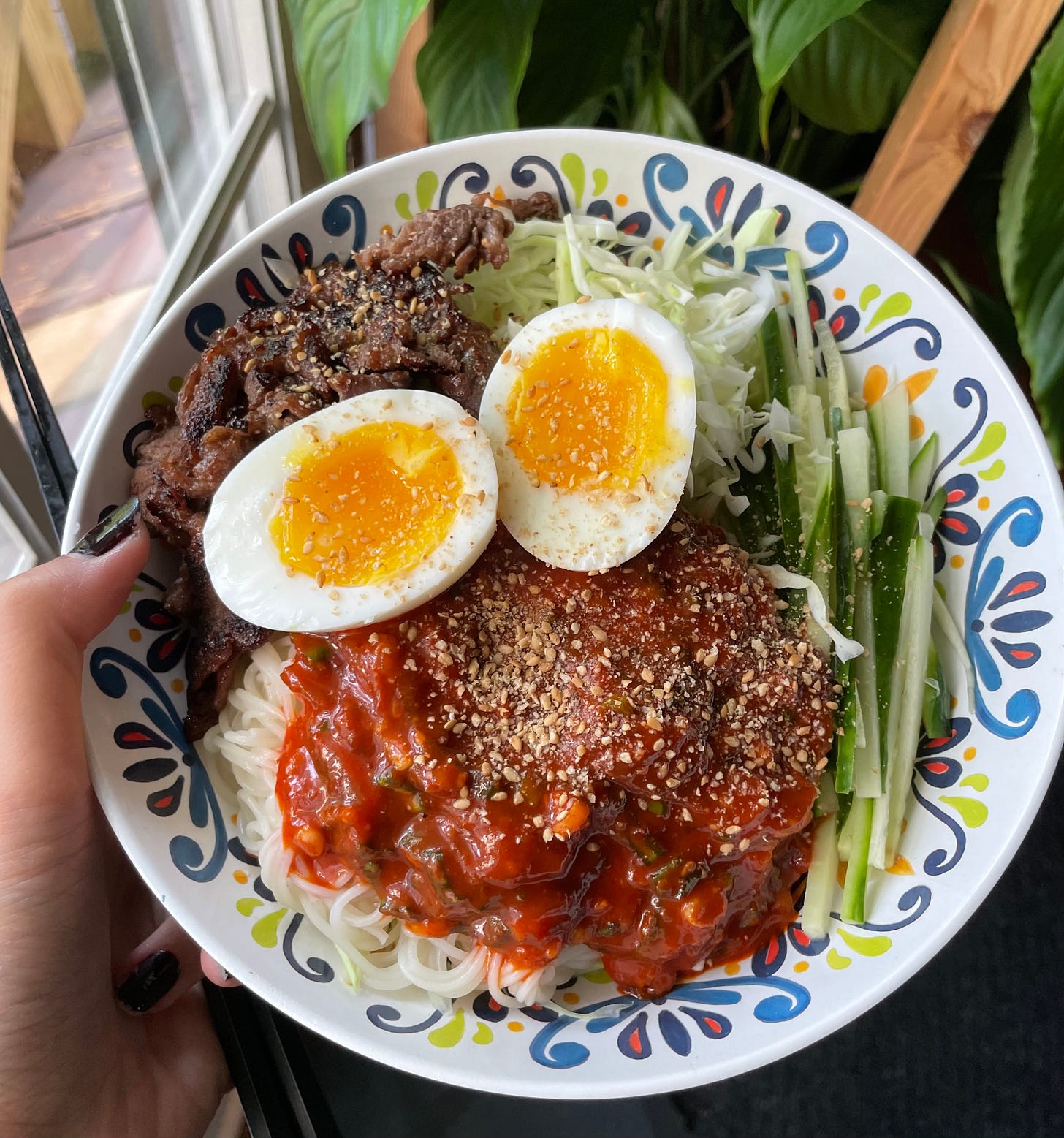


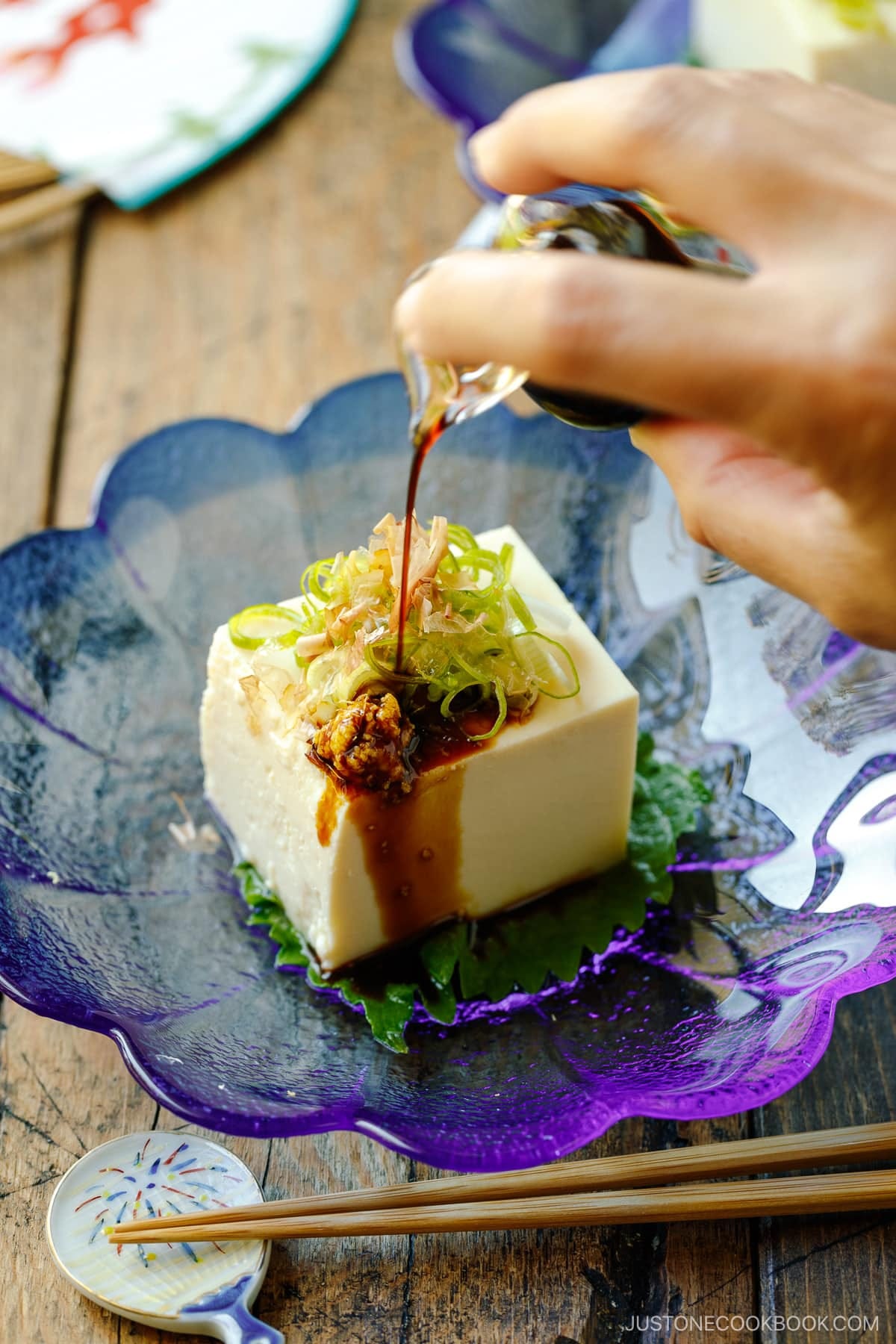
LOVE reading about all my favorite noodle dishes, and I learned some great hacks and shortcuts to try also. Well, all except the prepackaged soba dipping sauce...there is no substitute for using unprocessed katsuobushi (bonito flakes) and best kombu available.
That Bibim-guksu looks awesome, might try that this week. Thanks for the rec!